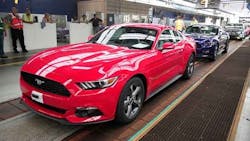The number of automobile dealerships in the United States appears to be picking up with an increase in car sales after steady declines since the recession began, says a new report on the impact of new car dealerships on the economy, by the Center for Automotive Research (CAR). At the same time, auto dealers are seeing new challenges with increased investments in technology and repair equipment needed to keep up, automakers toying around with the idea of direct sales and consumers hanging onto their vehicles longer than in the past.
In 2008, the United States had 19,226 new-car dealerships in operation, but by 2012 that had declined to 16,049. Since then, the number of dealerships has crept up again, to 16,396. This coincides with a steady increase in light vehicle sales, from a low point of 10.4 million vehicles in 2009 to 16.4 million in 2014.
CAR projects that light vehicle sales will continue to climb slightly each year to 17.7 million vehicles in 2018—comparable to the 17.4 million vehicles in the current record year of 2000.
The report shared some of the trends dealership owners can expect to see in the coming years:
Investment in new sales technology. Autonation, the largest dealership group in the country, is investing $100 million to develop its web presence as buyers increasingly migrate to third-party sites like Costco and Truecar. Other dealerships are integrating large flat-screen digital displays into their showrooms to display vehicle information and special deals. To streamline the buying process and integrate it more with the research consumers do online, some dealerships are investing more in tablets, mobile applications for sales personnel and customers, online credit applications, and software to match lenders with customers.
Automakers pursuing their own factory stores. Emerging legislation surrounding Tesla and its company-owned showrooms is worth watching, the report stated. Some states have passed new laws to allow direct sales in small numbers, which is making some dealers nervous that other auto manufacturers will set up their own factory stores and cut into dealership sales. Volvo, for instance, has announced it will launch its own web sales.
The need to keep up with advanced vehicle technology. Infotainment systems, alternative powertrain vehicles and advanced materials require additional equipment and training for both salespeople and repair technicians. Technicians trained in traditional powertrain vehicles may need additional specialization to repair the high-voltage electrical systems, lithium-ion batteries, and electric generators on electric and hybrid vehicles. And those repairs often require new tools, like $70,000 in upgraded equipment per work station to work on the aluminum body Ford F-150. Upgrades included rivet guns, welding equipment, hand tools, vacuum cleaners for aluminum dust and barriers for separating steel and aluminum work areas.
Keeping up with an aging vehicle fleet. Consumers with older vehicles tend to go to independent repair shops when their cars need work. And overall, vehicles are on the road longer than they used to be. To drum up more repair business, dealerships--which make a good chunk of their profits from parts and service--are increasingly offering services for older vehicles, including routine maintenance, service contracts, tire replacement, dent-and-ding repair, and oil changes.
About the Author

Laura Putre
Senior Editor, IndustryWeek
As senior editor, Laura Putre works with IndustryWeek's editorial contributors and reports on leadership and the automotive industry as they relate to manufacturing. She joined IndustryWeek in 2015 as a staff writer covering workforce issues.
Prior to IndustryWeek, Laura reported on the healthcare industry and covered local news. She was the editor of the Chicago Journal and a staff writer for Cleveland Scene. Her national bylines include The Guardian, Slate, Pacific-Standard and The Root.
Laura was a National Press Foundation fellow in 2022.
Got a story idea? Reach out to Laura at [email protected]
